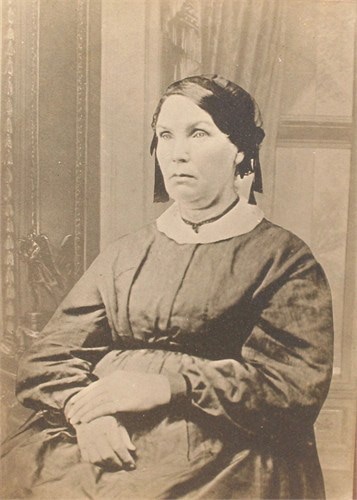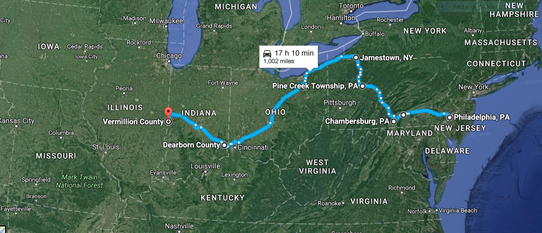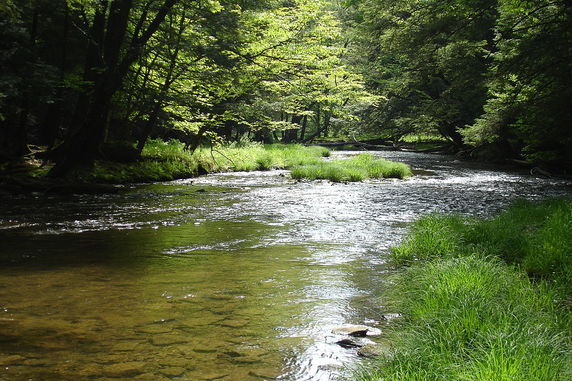|
When my Dad's 4x great grandfather, Edward Shillito, died in 1838, he left half of his 80 acres in Clinton Township, Vermillion County, Indiana to his only son, William, and the other half to the support of his wife, Sarah, and his 2 unmarried daughters, Polly and Rebecca. He divided his livestock among his wife and 5 living daughters, including my Dad's 3x great grandmother, Alice Harper, to whom he left a hog. Edward had been in his early 70s when he died, having been born in Northern Ireland about 1765 to George Shillito and his wife, whose name we don't know. The Shillito family were Scotch-Irish and Presbyterian, which meant that they faced both the enmity of the Catholics and the persecution of the Anglican English. From 1710 to 1775, over 200,000 Scotch-Irish decided to instead try their luck in America. In 1773, the Shillitos packed themselves into a wooden sailing ship and endured the 6 to 10 week crossing of the Atlantic to arrive in Philadelphia. As a weaver, George Shillito may chosen Philadelphia as a home for a very good reason: the city had a booming textiles industry and it lured professional weavers with inducements such as free land. Once settled into the city, George would have sent his children off to work as apprentices in various trades throughout the city. Although a weaver, he wouldn't have wanted all his sons to enter the same trade, as they would be in competition with one another. Edward likely was apprenticed to a millwright, who would have built or maintained grist and lumber mills. His older brother, George Jr, may have also been trained as a millwright, while a younger brother, William, trained with his father as a weaver. In addition to these trades, it's also likely that they would have farmed with their father. The family quickly found itself embroiled in the Revolutionary War and, as with most Scotch-Irish, their sympathies were very likely with independence. It's not clear whether the Shillitos fled Philadelphia when the British advanced on the city in 1777 or had left earlier, but the family relocated 120 miles west to Cumberland County. Although most of the the Shillito brothers were too young to fight in the war, George Jr. managed to enlist in 1778, at the age of 16, joining the Cumberland County militia. During the British occupation of Philadelphia, Edward may have remained near the city, working at his mill, or he may have returned after the British departure in 1778. Regardless, he resided in the county until at least 1784. Meanwhile, George Sr moved his family again, 30 miles southwest to Franklin County. At this time, this was the frontier, dense with overgrowth and prowled by wolves, whose howls kept the settlers up at night. George Sr established his home and livelihood on a half-acre on Washington Street in Chambersburg, where his property consisted of four buildings:
By 1790, Edward had joined his family in Franklin County, living near the households of his father and brother, William. In January of 1798, Edward married Sarah "Sally" Scott. There were several Scott families in Franklin County so she may have come from one of those, or perhaps Edward had moved on by then and had met her in Lycoming County. All we know is that by 1800, Edward had picked up his belongings and traveled 150 miles northwest to Pine Creek township, Lycoming County, in what is today Jefferson County. Samuel Scott had first arrived in Pine Creek in 1796 and decided that it was the ideal location for a saw mill. Together with his partners, they began construction of a saw mill in 1797, completing it in 1799. On an 1800 census, Samuel Scott and Edward Shillito were the only 2 declared millwrights in the township, although some farmers may have also worked as millwrights. By 1800, Edward had 2 daughters: Elizabeth (b. 1798) and Rebecca (b.1800). However, the first child credited as born in Pine Creek belonged to Samuel Scott, so it's possible that Edward did not move there until 1800. Edward's daughter, Elizabeth, would later marry James Wood and name their first son Samuel Scott Wood, so it's possible that Samuel Scott and Sally Scott were related. To add some weight to this possibility, there are some DNA matches between my family and descendants of Samuel Scott. After 5 years in Pine Creek, Edward and Sally were ready for a new challenge. Packing up their belongings and 3 daughters, they traveled north through the Allegheny Forest, herding a few cows along with them. Only a few hundred settlers had preceded them along this trail, felling trees to establish small farms. Their destination was a small settlement on the Conewango Creek, a few miles east of Chautauqua Lake, just south of Lake Erie. A few months earlier, Dr. Thomas Kennedy had purchased 3,000 unsurveyed acres from the Holland Land Company. Kennedy, Edward Work and Edward Shillito began construction of a double saw mill in the summer of 1805. Shillito lived with his family at the mill, along with all the workers. They cultivated fields around the construction site, planting corn and potatoes.
Kennedy had hired some men to bring supplies by canoe, down the Allegheny river and along various trails, but they were very delayed. Fortunately, between the crops and one of Edward's heifers, they had food enough until the supplies arrived in the fall. On October 5, they raised the frame of the mill and were soon in operation. Edward, Sally, and their daughters continued to live at the mill, providing board for many of the workers. Lumber cut at the mill was shipped south in flat bottomed boats to be sold in New Orleans, with Work accompanying each shipment to negotiate the sale. The men transporting the lumber then returned north via ship to Philadelphia and then returned to the mill via canoe and horseback, since returning upriver through Indian territory was considered too dangerous. The following year, while still living at the mill, Sally gave birth to another daughter, Jane. The family would live at the mill for almost 2 more years. On May 13, 1808, Edward purchased land from the Holland Land Company on the north side on the inlet to Chautauqua Lake. Several more mills were built in the area and Edward likely had a lot of work. The lived at this property for 10 years, with Edward making several additional payments towards its purchase. Sally and Edward would also have several more children: Polly, Alice, Clarissa, and then a son, William. In 1817, Judge John Watts built a grist and saw mill on Laughery Creek in Dearborn County, Indiana. In 1818, seemingly with a taste for frontier life, Edward, Sally, and their family relocated 400 miles southwest to a small settlement on the north bank of the creek named Hanover. The Shillitos may have only farmed or Edward may have worked on the mills. In Dearborn, Edward and Sally's eldest daughter, Elizabeth, married James Wood from New York. Their 3rd daughter, Jane, married Artemus Clark, also of New York and a veteran of the War of 1812. Shortly after 1820, Edward and Sally pressed west yet again, accompanied by their new son-in-laws and grandchildren, to settle 180 miles west in Vermillion County. It was here that Alice Shillito met and married James Harper, born in Kentucky, whose family had come from Virginia. Clarissa would marry George Damon in January 1830 but he died 3 years later, leaving her with 2 children. A few years later, she would then remarry a man named Popham, who appears to have also widowed her before 1840. Edward and Sally farmed for several years, with Rebecca, Polly, and William living with them. He would live to see the birth of his granddaughter, Mary Jane Harper, my 2x great grandmother. After he passed away in 1838, the family remained together on the farm for several years. William would marry Phebe Caldwell in 1840 and move out to set up a new household. Sally and her daughters remained in the home until sometime after 1850, when they disappeared. Perhaps the remaining daughters married and changed their names or perhaps they passed away. Following in the tradition of their parents, James and Alice Harper would take their family west again, to Linn Township in Dallas County, Iowa. In 1860, the Harpers hired a young man named Nathan Hethcot to do some work around the farm. Nathan and Mary Jane married the following year. Their daughter, Emma, would be the mother to my grandfather, Lowell Simpson. Comments are closed.
|
Archives
2023 JAN FEB MAR APR MAY JUN JUL AUG SEP 2022 JAN FEB MAR APR MAY JUN JUL AUG SEP OCT NOV DEC 2021 JAN FEB MAR APR MAY JUN JUL AUG SEP OCT NOV DEC 2020 JAN FEB MAR APR MAY JUN JUL AUG SEP OCT NOV DEC 2019 JAN FEB MAR APR MAY JUN JUL AUG SEP OCT NOV DEC 2018 JAN FEB MAR APR MAY JUN JUL AUG SEP OCT NOV DEC 2017 JAN FEB MAR APR MAY JUN JUL AUG SEP OCT NOV DEC 2016 JAN FEB MAR APR MAY JUN JUL AUG SEP OCT NOV DEC 2015 JAN FEB MAR APR MAY JUN JUL AUG SEP OCT NOV DEC 2014 OCT NOV DEC Categories |



 RSS Feed
RSS Feed